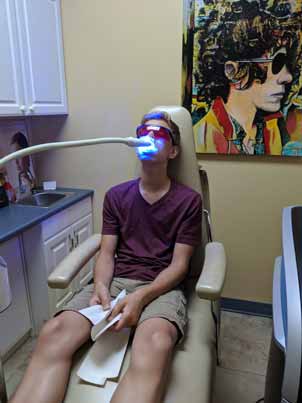Teeth Whitening
How it Works
How Teeth Whitening Works
 During your visit here’s how teeth whitening works, we will have you make a custom teeth impression (mouthpiece) that you can keep for future teeth whitening session saving you time and money. If you lose your impression we will have to charge you $20 for replacements. The next step in the teeth whitening process, we will have you apply Vitamin E with a cotton swab on your gums (this protects them from sensitivity from the gel). Next, we’ll apply the peroxide solution to your impression and have you insert it.
During your visit here’s how teeth whitening works, we will have you make a custom teeth impression (mouthpiece) that you can keep for future teeth whitening session saving you time and money. If you lose your impression we will have to charge you $20 for replacements. The next step in the teeth whitening process, we will have you apply Vitamin E with a cotton swab on your gums (this protects them from sensitivity from the gel). Next, we’ll apply the peroxide solution to your impression and have you insert it.
You will wear safety glasses to shield your eyes from the bright blue light. Unwind and relax during the next 20 minutes and allow each session to work, these sessions may get your teeth 2-3 shades brighter. You can do these as often as you’d like and do multiple sessions back to back for maximum results. Although your teeth may get sensitive if you decide to do 2-3 sessions. After your treatment, you will rinse your mouth and impression, then examine the results, which will continue to brighten for 2-3 hours. The length of time the whitening lasts is based on each individual’s habits. If you smoke, drink coffee, wine, or eat dark sauces these will all affect your teeth.



Preventing Stained Teeth
There are many simple ways you can prevent staining your teeth or just learn how to protect your investment by extending results. Here are just a few ways:
- Don’t smoke or chew tobacco. The nicotine and tar have residual build up on your teeth, mouth, and lungs.
- Practice proper oral hygiene. Brush, floss, and mouthwash at least twice a day.
- Go to the Dentist every six months for a cleaning and checkup.
- Avoid consuming acidic food, sauces, and wines as much as possible.
- Avoid swishing beverages or use a straw when drinking dark beverages. It stops the liquid from hitting your teeth and staining them.
- Get your teeth whitened periodically.
- Choose your toothpaste carefully.
Colors and Types of Teeth Stains and What Causes Them
Green Teeth – Teeth have not been clean thoroughly, the plaque has bacteria or fungi, Eating foods with chlorophyll can be a cause, Hyperbilirubinemia can cause green teeth or exposure to copper and Nickel as children.
Orange Stains – Chromogenic bacteria, Doxycycline use, Metals, Porphyria (Gunther’s Disease).
Brown/Black Stains – Drinking dark colored drinks such as tea or coffee, smoking often, cavities, interior damage to the tooth, soy sauce, tomato sauce, curry, popsicles, sugar-based foods, and sticky foods.
Greyish Blue to Brownish yellow – Tetracycline, minocycline, doxycycline, during the development of the teeth can cause this, tooth decay, chewing tobacco.
Black spots – Dental caries, Tooth decay, Fluorosis, smoking, caffeine, drugs, poor oral hygiene, leaking amalgam restorations, calculus, pulp necrosis.
White Spots/Streaks on teeth – Dental Fluorosis (high concentrations of fluoride during tooth development), Hypocalcification (insufficient enamel calcification), Enamel Hypoplasia (tooth demineralization), Enamel (Ectodermal) Dysplasia (severe tooth deformation and large spaces between the teeth).









